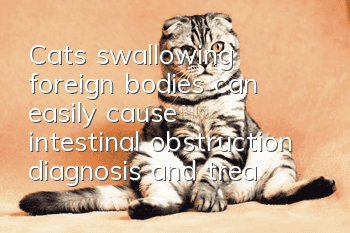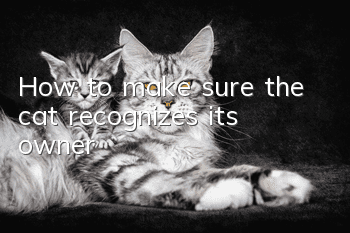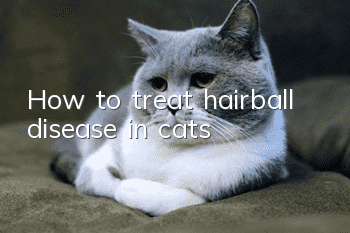Cats swallowing foreign bodies can easily cause intestinal obstruction (diagnosis and treatment of intestinal obstruction in cats)

Clinically, feline intestinal obstruction is a common internal digestive system disease. Generally speaking, it is intestinal blockage caused by accidental ingestion of foreign bodies. Particularly common in kittens. Kittens often swallow messy things "silly". For example:
-
The plastic bag was damaged for no reason.
-
The feathers that mysteriously disappeared from the cat-catching stick.
-
The bones that fell from the dining table suddenly disappeared.
Yes, these are the culprits that cause intestinal obstruction in cats. Cats swallow foreign bodies, and the foreign bodies cannot pass through the intestines smoothly, affecting the normal operation of the digestive system. Symptoms of intestinal obstruction usually include vomiting, not eating or drinking, obvious pain when touching the abdomen, and constipation and blood in the stool.
Diagnosis of intestinal obstruction in cats
Abdominal palpation, when a hard lump is felt, the cat becomes sensitive and resists palpation. For further diagnosis, you need professional equipment. Usually, blood routine examination, blood biochemistry, and X-ray examination are considered for clinical examination.
Blood routine: Blood routine mainly looks at whether the white blood cells are abnormal. Usually intestinal obstruction can easily cause an inflammatory reaction in the body, and the white blood cells will be higher than the reference value.
Blood biochemistry: Mainly checks whether the liver and kidney functions are normal. Elevated concentrations of urea nitrogen and creatinine in the blood indicate abnormal liver and kidney function.
X-ray examination: Foreign bodies in the intestines can be clearly seen.
Cat intestinal obstruction can be diagnosed through the above diagnostic methods.
Treatment options for cat intestinal obstruction
Conservative treatment can be used for incomplete blockage, while surgical treatment can only be used for complete blockage. No matter which method is recommended, it is recommended to be performed in the hospital. It is very difficult for individuals to handle it at home.
Conservative treatment: Take 50 mL of 6% magnesium sulfate or sodium sulfate solution or 30 mL of vegetable oil by gavage. Use abdominal massage or directly crush the obstruction to expel the contents from the body. If the obstruction occurs in the lower intestine, a deep enema can be performed using large amounts of liquid paraffin. At the same time, supportive therapies such as infusion, anti-inflammation, nutritional supplementation, and correction of acid-base balance are performed.
Surgical treatment: If conservative treatment is ineffective, surgical treatment should be performed as soon as possible, otherwise it will be life-threatening. Under conventional anesthesia, lie supine and Baoding, trim and disinfect the area from the xiphoid cartilage to the front edge of the pubic bone, open the abdominal cavity along the midline of the abdomen, detect the obstructed intestinal tube, pull the obstructed intestinal tube out of the wound, andUse gauze soaked in saline to isolate the intestines from the wound to prevent intestinal contents from flowing into the abdominal cavity. Use intestinal forceps to clamp both sides of the obstructed intestinal tube. If the intestinal viability is normal, make a longitudinal incision in the intestinal tube on the opposite side of the mesentery, remove the obstruction, rinse it with normal saline, and suture the intestinal incision with the catgut nodules. If the intestinal tube is severely congestion or necrotic, partial intestinal resection and end-to-end anastomosis will be performed. Finally, the omentum will cover the intestinal tube at the surgical site, and the abdominal cavity will be closed routinely. Fasting for 3 to 4 days after surgery, intravenous infusion, anti-inflammation, nutrition and water supplementation; liquid food to be fed for 4 to 5 days, and then gradually transitioning to normal food.
Rough calculation, surgical treatment for intestinal obstruction is conservatively estimated to cost at least 2,000+ RMB. This is a completely avoidable disease, we just need to do the following things.
-
Store away foreign objects that cats may accidentally eat. Especially kittens, which are very curious and have a habit of swallowing foreign objects. If people go out, you may consider keeping them in cages.
-
It is worth noting that hairballs can occur when cats lick their fur. If a cat cannot vomit hairballs, it may easily cause intestinal obstruction. Drink plenty of water, feed cat grass or hair-reducing cream, and comb your hair frequently.
-
Prevent constipation and eat healthily. Constipation is also one of the common causes of intestinal obstruction. Cats are encouraged to drink more water. If the cat is prone to constipation, additional probiotics can be added to the food.
-
Regular deworming. Intestinal obstruction due to parasites in domestic cats is uncommon but should be noted. Internal deworming should be done at least once every 3 months.
Intestinal obstruction is a common disease that should attract parents' attention and, more importantly, prevent it before it happens. Store dangerous goods in your home well. Fragmented items are the best protection.
- What breed is the elf cat?
- How to choose a more suitable freeze-dried cat food for cats?
- Can the incubation period of cat plague last 20 days without getting sick?
- How to choose a Devon Curl Cat_Habits and Characteristics_Raising and Price
- What should I do if the male cat doesn’t mate?
- Why do kittens suddenly vomit?
- Can cats be dewormed internally and externally at the same time?
- Are Siamese cats clingy?
- Why does Garfield need to be neutered?
- Things to pay attention to when bathing Garfield cats



